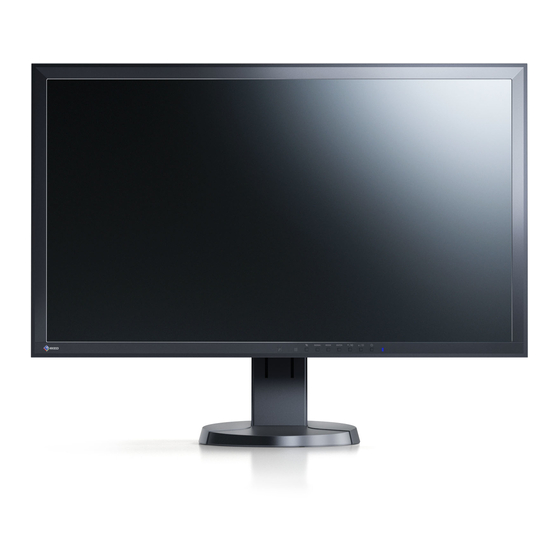
Table of Contents
Advertisement
Quick Links
Important
Please read PRECAUTIONS, this User's Manual, and the Setup Guide
(separate volume) carefully to familiarize yourself with safe and
effective usage.
• Please refer to the Setup Guide for basic information ranging from
connection of the monitor to a PC to using the monitor.
• The latest User's Manual is available for download from our web site:
http://www.eizoglobal.com
Advertisement
Table of Contents

Summarization of Contents
Chapter 1 Introduction
1-1. Features
Lists the key features of the EIZO FlexScan EV2736W monitor.
1-2. Controls and Functions
Details the monitor's buttons, sensors, ports, and other controls.
1-3. EIZO LCD Utility Disk
Information about the included software disk and its contents.
1-4. Basic Operations and Functions
Guide to operating the monitor's setting menus and basic functions.
Chapter 2 Adjusting Screens
2-1. Compatible Resolutions
Lists supported display resolutions for DVI-D and DisplayPort inputs.
2-2. Setting the Resolution
Step-by-step instructions for setting display resolution across different operating systems.
2-3. Adjusting Color
Guidance on various color adjustments available for the monitor.
To select the display mode (FineContrast Mode)
How to choose predefined display modes for optimal image application.
To perform advanced adjustments
Guidance on making detailed color adjustments within the monitor's settings.
To adjust brightness
Instructions on how to manually adjust the screen's backlight brightness level.
To adjust contrast
Steps to adjust the contrast for image depth and detail.
To adjust color temperature
How to change the color temperature (e.g., Kelvin) for a desired white balance.
To adjust gamma
Guide on adjusting gamma correction for optimal brightness and contrast balance.
To adjust the color saturation
Instructions for modifying the intensity of colors displayed on the screen.
To adjust hue
How to fine-tune the color tint of the displayed image.
To set overdrive intensity
Adjusting overdrive for faster response times, reducing motion blur.
To adjust gain
Steps to adjust the intensity of red, green, and blue color components.
2-4. Screen Size Changing
How to adjust the displayed image size to Full Screen, Enlarged, or Normal.
To modify blurred characters / lines
Adjusting smoothing to improve clarity of text and lines at low resolutions.
Chapter 3 Setting Monitor
3-1. Adjusting Volume
How to control the audio output volume for the monitor's speakers.
3-2. Selecting Sound Source
Choosing audio input between DisplayPort and Stereo Mini Jack.
3-3. Enabling / Disabling DDC/CI Communication
Activating or deactivating monitor-PC communication for settings.
3-4. Locking Operation Buttons
Securing monitor settings to prevent unintended changes by locking buttons.
3-5. Showing and Hiding EIZO Logo
Option to display or hide the EIZO logo on startup.
3-6. Changing Setting Menu Display Position
Adjusting the on-screen location of the monitor's menu.
3-7. Setting Language
Selecting the display language for the monitor's menus and messages.
3-8. Resetting Monitor to Default Settings
Restoring monitor settings to factory defaults for color, EcoView, or all functions.
Chapter 4 Power Saving Functions
4-1. Setting Power Saving
Configuring the monitor to enter power saving mode based on PC status.
4-2. Setting Power Indicator
Turning the monitor's power status indicator light on or off.
4-3. Enabling / Disabling Automatic Brightness Adjustment
Using the ambient light sensor to automatically adjust screen brightness.
4-4. Setting Power Saving Mode for Person Absence
Configuring EcoView Sense to automatically save power when no user is present.
4-5. Checking Power Saving Level
Viewing power reduction, CO2 reduction, and eco performance indicators.
4-6. Enabling / Disabling Auto Power-OFF
Setting the monitor to automatically turn off after a period in power saving mode.
Chapter 5 Troubleshooting
5-1. No Picture
Diagnosing and resolving issues where the screen displays no image.
5-2. Imaging Problems
Troubleshooting common display issues like brightness, blurriness, and afterimages.
5-3. Other Problems
Addressing miscellaneous issues such as menu access, audio, and USB connectivity.
Chapter 6 Reference
6-1. Attaching the Optional Arm
Instructions for mounting the monitor using an optional arm or stand.
6-2. Connecting Multiple PCs
Information on connecting and managing multiple computer inputs.
To switch among input signals
How to cycle through different connected PC input sources.
To set input signal selection
Configuring automatic or manual selection of the active input signal.
6-3. Making Use of USB
Details on utilizing the monitor's built-in USB hub functionality.
Connection Procedure (Setup of USB Function)
Steps to connect the monitor's USB hub to a PC and peripheral devices.
6-4. Displaying Monitor Information
Accessing details like model name, serial number, and usage time.
6-5. Specifications
Technical details and performance metrics of the monitor.
Main Default Settings
Table showing the factory default configurations for various monitor functions.
Outside Dimensions
Technical drawings with measurements of the monitor's physical size.
6-6. Glossary
Definitions of technical terms and acronyms used in the manual.
Appendix
Trademark
List of registered trademarks and company names mentioned in the manual.
License
Information regarding font usage within the product.
TCO
Details about the TCO standard compliance for office equipment.
FCC Declaration of Conformity
Regulatory compliance statement for the product in the USA and Canada.















Need help?
Do you have a question about the FlexScan EV2736W-BK and is the answer not in the manual?
Questions and answers